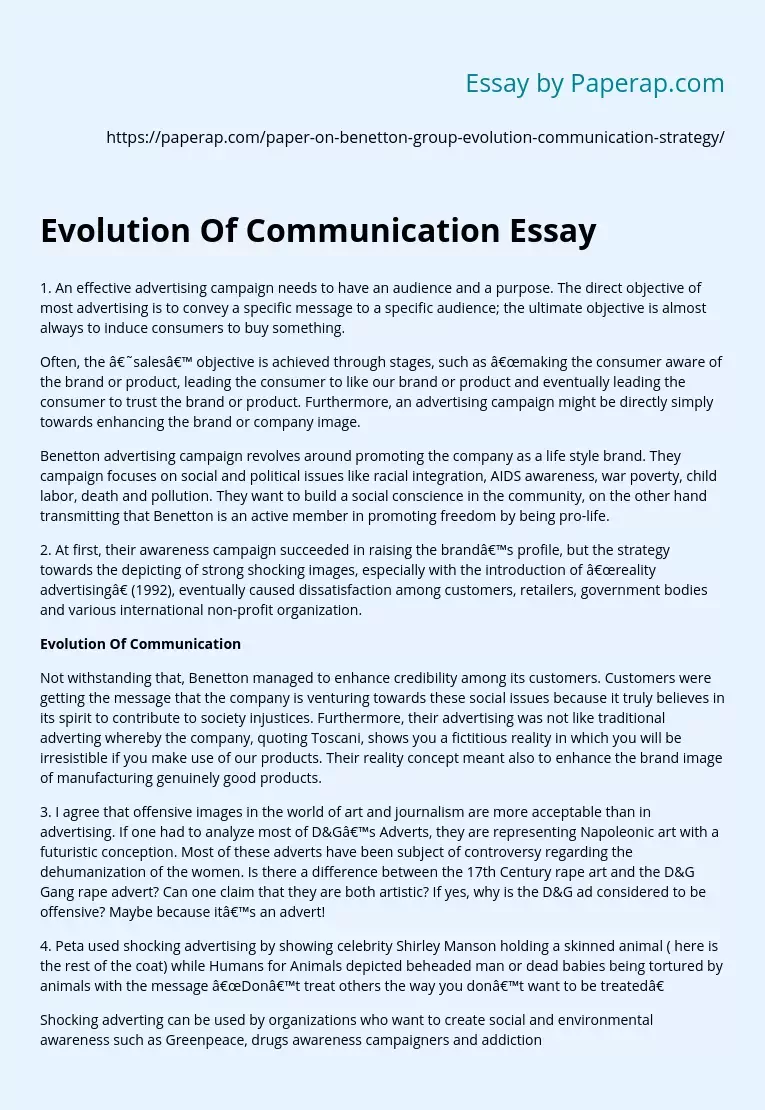Evolution Of Communication Essay
1. An effective advertising campaign needs to have an audience and a purpose. The direct objective of most advertising is to convey a specific message to a specific audience; the ultimate objective is almost always to induce consumers to buy something.
Often, the ‘sales’ objective is achieved through stages, such as “making the consumer aware of the brand or product, leading the consumer to like our brand or product and eventually leading the consumer to trust the brand or product. Furthermore, an advertising campaign might be directly simply towards enhancing the brand or company image.
Benetton advertising campaign revolves around promoting the company as a life style brand. They campaign focuses on social and political issues like racial integration, AIDS awareness, war poverty, child labor, death and pollution. They want to build a social conscience in the community, on the other hand transmitting that Benetton is an active member in promoting freedom by being pro-life.
2. At first, their awareness campaign succeeded in raising the brand’s profile, but the strategy towards the depicting of strong shocking images, especially with the introduction of “reality advertising” (1992), eventually caused dissatisfaction among customers, retailers, government bodies and various international non-profit organization.
Evolution Of Communication
Not withstanding that, Benetton managed to enhance credibility among its customers. Customers were getting the message that the company is venturing towards these social issues because it truly believes in its spirit to contribute to society injustices. Furthermore, their advertising was not like traditional adverting whereby the company, quoting Toscani, shows you a fictitious reality in which you will be irresistible if you make use of our products.
Their reality concept meant also to enhance the brand image of manufacturing genuinely good products.
3. I agree that offensive images in the world of art and journalism are more acceptable than in advertising. If one had to analyze most of D&G’s Adverts, they are representing Napoleonic art with a futuristic conception. Most of these adverts have been subject of controversy regarding the dehumanization of the women. Is there a difference between the 17th Century rape art and the D&G Gang rape advert? Can one claim that they are both artistic? If yes, why is the D&G ad considered to be offensive? Maybe because it’s an advert!
4. Peta used shocking advertising by showing celebrity Shirley Manson holding a skinned animal ( here is the rest of the coat) while Humans for Animals depicted beheaded man or dead babies being tortured by animals with the message “Don’t treat others the way you don’t want to be treated”
Shocking adverting can be used by organizations who want to create social and environmental awareness such as Greenpeace, drugs awareness campaigners and addiction prevention centers. From the example above animal right movements might only employ effectively shocking advertising.
5. I believe that shocking advertising most often repel the audience. In addition, these adverts might distort the customers from the main objectives of purchasing the brand. At subconscious level they might associate Benetton more with their human right campaign than with the products they actually offer. The use of conventional advertising will assist the company gaining back some of the brand reputation. Through the use of conventional advertising they can still transmit the core notions of “peace and unity’, which are their strong points, without risking to negatively influencing their audience. Such a strategy would still make them innovative.
Evolution Of Communication Essay. (2019, Dec 05). Retrieved from https://paperap.com/paper-on-benetton-group-evolution-communication-strategy/

